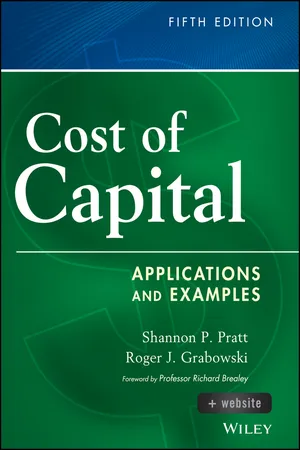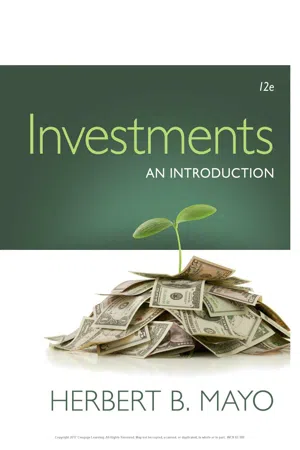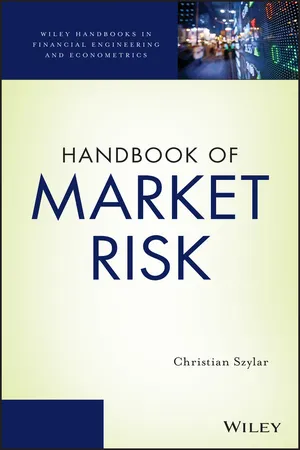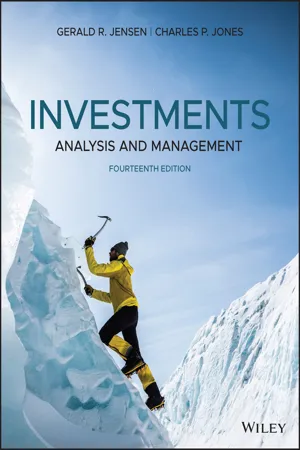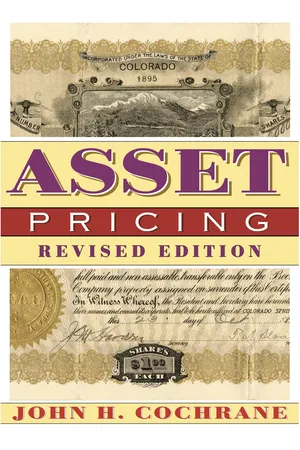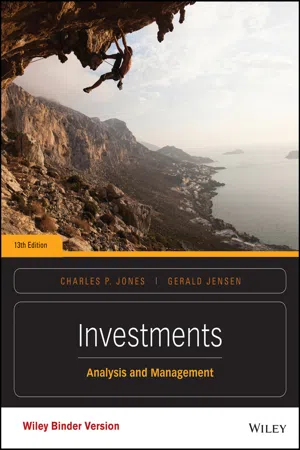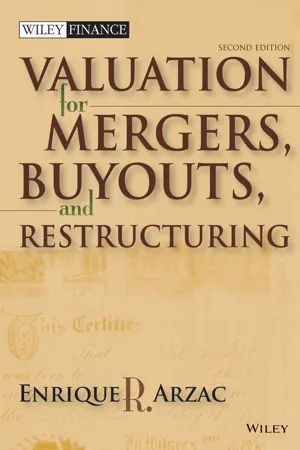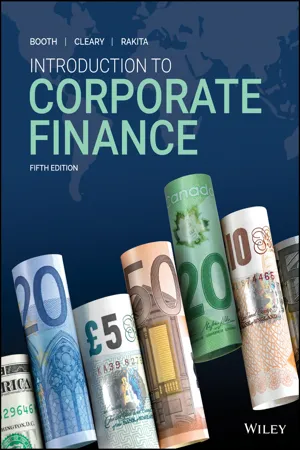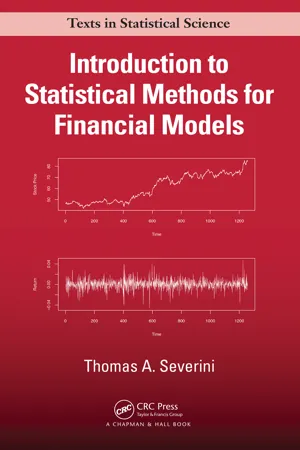Business
Capital Asset Pricing Model
The Capital Asset Pricing Model (CAPM) is a financial model used to determine the expected return on an investment based on its risk. It takes into account the risk-free rate of return, the market risk premium, and the asset's beta, which measures its volatility in relation to the overall market. CAPM is widely used in finance to evaluate the potential return of an investment relative to its risk.
Written by Perlego with AI-assistance
Related key terms
1 of 5
12 Key excerpts on "Capital Asset Pricing Model"
- eBook - ePub
Cost of Capital
Applications and Examples
- Shannon P. Pratt, Roger J. Grabowski(Authors)
- 2014(Publication Date)
- Wiley(Publisher)
Chapter 10 Capital Asset Pricing Model- Introduction
- Concept of Market or Systematic Risk
- Background of the Capital Asset Pricing Model
- Market (or Systematic) and Unique (or Unsystematic) Risks
- Using Beta to Estimate Expected Rate of Return
- Modifying CAPM
- Firm Size Phenomenon
- Company-specific Risk Factor
- Modified CAPM Cost of Capital Formula
- Examples of a CAPM Model
- Example of CAPM Method Using Morningstar Data
- Example of a CAPM Method Using Duff & Phelps Size Study Data
- Assumptions Underlying the Capital Asset Pricing Model
- Summary
Introduction
The Capital Asset Pricing Model (CAPM) has served as the foundation for pricing risk for nearly fifty years. One author has summarized its acceptance this way:Modern academic finance is built on the proposition that markets are fundamentally rational. The foundational model of market rationality is the CAPM. The implications of rejecting market rationality as encapsulated by the CAPM are very considerable. In capturing the idea that markets are inherently rational, the CAPM has made finance an appropriate subject for econometric studies. Industry has come to reply on the CAPM for determining the discount rate for valuing investments within the firm, for valuing the firm itself, and for setting sales prices in the regulation of utilities, as well as for such purposes as benchmarking fund managers and setting executive bonuses linked to adding economic value.1Financial theorists generally have favored using the CAPM as the preferred method to estimate the cost of equity capital, and the CAPM has become the most widely used method for estimating the cost of equity capital.2As with any model, certain assumptions are made in developing CAPM, and those assumptions also represent limitations. Despite its limiting assumptions, CAPM helps explain the relationship of the risk among stocks and their expected returns.Concept of Market or Systematic Risk
The CAPM has many critics. The basic criticisms are not about the theoretical underpinnings of the CAPM. Rather they center on an underlying premise of the CAPM: - No longer available |Learn more
Investments
An Introduction
- Herbert Mayo(Author)
- 2016(Publication Date)
- Cengage Learning EMEA(Publisher)
That is, the concept is applied in both a macro context that specifies the relationship between risk and the return on a portfolio and a micro context that specifies the relationship between risk and the return on a specific asset. The macro aspect of the CAPM is the development of the capital market line . Figure 5.11 begins with all the possible efficient portfolios of risky securities and adds C AP ITAL M ARKE T L INE FIGURE 5.11 Retur n (%) r f Z X Y A B Risk: Por tfolio Standard Deviation ( p ) σ ( ( p p S OU RCE : © Cengage Learning 3 For the seminal work on CAPM, see William Sharpe, “Capital Asset Prices: A Theory of Market Equilibrium,” Journal of Finance (September 1964): 425–442; John Lintner, “The V aluation of Risk Assets and the Selection of Risk I nvestments in Stock Portfolios and Capital Budgets,” Review of Economics and Statistics (February 1965): 13–37; and Jan Mossin, “Equilibrium in a Capital Asset Market,” Econometrica (October 1966): 768–783. The contributions of Markowitz and Sharpe to the analysis of risk and the development of portfolio theory are so important that they, along with Merton Miller, were awarded the Nobel Prize in economics in 1990. Copyright 2017 Cengage Learning. All Rights Reserved. May not be copied, scanned, or duplicated, in whole or in part. WCN 02-300 C H A P T E R F I V E Risk and Portfolio Management 161 line AB , which begins at r f on the Y-axis and is tangent to the efficient frontier. AB is the capital market line specified by the Capital Asset Pricing Model. Each point on the line represents a combination of the risk-free security and a portfolio encompassing risky securities. If investors bear no risk and invest their entire portfolios in risk-free assets, they should earn a return equal to r f r r . As investors substitute risky securities for the risk-free assets, both risk and return increase (i.e., there is movement along the capital market line). - eBook - ePub
- Christian Szylar(Author)
- 2013(Publication Date)
- Wiley(Publisher)
hapter FiveThe Capital Asset Pricing Model and the Arbitrage Pricing TheoryEvery model is wrong, but some are useful.—George BoxThe original Capital Asset Pricing Model (CAPM) was derived by Sharpe, Lintner, and Mossin in 1964. We will consider this original model as well as extensions of it in lectures that follow. As with every other model, CAPM requires simplifying assumptions because of the complexity of the real world. There are a number of assumptions underlining the CAPM model, but only three of those are absolutely necessary for deriving the CAPM. The assumptions are as follows:1. One-period investment horizon.2. Rational, risk-averse investors.3. Unlimited borrowing and lending is allowed at a risk-free rate that is the same for all investors.4. There are no taxes.5. There are no transaction costs and inflation.6. All assets are infinitely divisible.7. Free flow and instant availability of information.8. There are many investors on the market.9. All assets are marketable.10. All investors have homogeneous expectations about expected returns, variances, and covariances of assets.Also, we have shown that in the presence of a risk-free asset and under the assumptions that all individuals (i) face the same universe of assets, (ii) have the same investment horizon, and (iii) have the same expectations about future returns, variances, and covariances, and efficient portfolios will be combinations of the tangent portfolio and the risk-free asset.Hence, we can conclude that assumptions 1, 3, and 10 are the most relevant assumptions in deriving CAPM. However, it is obvious that the reality is distorted by making most of the assumptions outlined above. - eBook - PDF
Investments
Analysis and Management
- Gerald R. Jensen, Charles P. Jones(Authors)
- 2019(Publication Date)
- Wiley(Publisher)
Beta is the only company-specific factor in the CAPM; therefore, risk is the only asset-specific forecast that must be made. Thus, the CAPM is frequently referenced as a single-factor model. According to the CAPM, the only factor that differentiates the returns of one asset from another asset is the asset’s beta. β x β y Beta X Y Z Expected (required) return E(R y ) E(R y 1) E(R x ) RF E(R x 1) FIGURE 9.8 Overvalued and undervalued securities using the SML 244 Chapter 9 Capital Market Theory and Asset Pricing Models Tests of the CAPM The conclusions of the CAPM are entirely sensible: 1. Expected return and risk are positively related—greater risk implies greater expected return. 2. The relevant risk for a security is a measure of its effect on portfolio risk. The question, therefore, is how well the theory works. After all, the assumptions on which capital market theory (CMT) rest are, for the most part, unrealistic. To assess the validity of this or any other theory, empirical tests must be performed. If the CAPM is valid, and the market tends to balance out so that the model provides reasonably accurate forecasts for security returns, equations of the following type can be estimated: R a a i i 1 2 (9-4) where R i i the average return on security over some number of periods the estimated beta for security i i When Equation 9-4 is estimated, a 1 should approximate the average RF during the periods studied, and a 2 should approximate the average market risk premium during the periods studied. An extensive literature exists involving tests of the CAPM. Although it is not possi- ble to summarize the scope of this literature entirely and to reconcile findings from different studies that seem to be in disagreement, the following points represent a reasonable consensus of the empirical results 7 : 1. The SML appears to be linear; that is, the trade-off between expected (required) return and risk is an upward-sloping straight line. - eBook - PDF
Investments
Analysis and Management
- Gerald R. Jensen, Charles P. Jones(Authors)
- 2020(Publication Date)
- Wiley(Publisher)
In fact, Roll has argued that the CAPM is untestable because the market portfolio, which consists 7 For a discussion of empirical tests of the CAPM, see Elton, Gruber, Brown, and Goetzmann, Modern Portfolio Theory and Investment Analysis , 9th ed. (John Wiley & Sons, Inc., 2014). Arbitrage Pricing Theory 245 of all risky assets, is unobservable. 8 In effect, Roll argues that tests of the CAPM are actually tests of the mean-variance efficiency of the market portfolio. Nevertheless, the CAPM remains a logical way to view the risk-expected return trade-off and is a frequently used model in finance. Arbitrage Pricing Theory The CAPM is not the only model of security pricing. Another model that has received attention is based on arbitrage pricing theory (APT) as developed by Ross and enhanced by others. In recent years, APT has emerged as an alternative theory of asset pricing to the CAPM. Its appeal is that it is more general than the CAPM, with less restrictive assumptions. However, like the CAPM, it has limitations, and like the CAPM, it is not the final word in asset pricing. Similar to the CAPM, or any other asset pricing model, APT posits a relationship between expected return and risk. It does so, however, using different assumptions and procedures. Very importantly, APT is not critically dependent on an underlying market portfolio. In contrast, the CAPM predicts that only market risk influences expected returns. Instead, APT recognizes that several types of systematic risk may affect security returns. The Law of One Price APT is based on the law of one price , which states that two otherwise identical assets cannot sell at different prices. APT assumes that asset returns are linearly related to a set of indexes, where each index represents a factor that influences the return on an asset. Market participants develop expectations about the sensitivities of assets to the factors. - eBook - PDF
- G. Gregoriou, R. Pascalau, G. Gregoriou, R. Pascalau(Authors)
- 2010(Publication Date)
- Palgrave Macmillan(Publisher)
The normality assumption makes CAPM derivation statistically tractable but an investor’s preferences are not necessarily consistent with the mean and variance of return. The CAPM considers beta as the sole measure of systematic risk in a diversified portfolio. The beta is estimated via a market model and is assumed valid under all market conditions. However, several alternative theories based on different perceptions of systematic risk have chal- lenged the dominance of the mean–variance notion of the risk-return relationship. One of the most prominent of these is the asset-pricing theory that recognizes deviation only below a target rate of return as risky. Downside risk measures and the associated asset-pricing mod- els are motivated by economic and statistical considerations – investor psychology is consistent with an asymmetric treatment of the varia- tions in the returns and the empirical return distributions appear to be non-normal. 1 Harlow and Rao (1989) (henceforth referred to as H&R) developed an asset-pricing model that measures risk based on the deviations of returns from an arbitrary target rate. The asset-pricing model is similar to the 154 Testing the Lower Partial Moment Asset-Pricing Models 155 CAPM and can be expressed as: E(R i ) = R f + β MLPM( ) i E(R m ) − R f (6.1) When E(R i ) and E(R m ) denote the expected returns of asset i and the market m, respectively, then: β MLPM( ) i = E (R i − R f ) min(R m − ,0) E [min(R m − ,0)] 2 (6.2) where R f is the risk-free rate and is an arbitrary target rate. In this model, a particular asset contributes to the risk only if the market return is below the target rate . We refer to (6.1) as the mean lower partial moment (MLPM) model. Asset-pricing models based on the notion of downside risk are appropriate when asset returns are not symmetrical. Asymmetric asset returns are more pronounced in emerging markets than in developed markets. - eBook - PDF
Asset Pricing
Revised Edition
- John H. Cochrane(Author)
- 2009(Publication Date)
- Princeton University Press(Publisher)
But the best minds in finance have been working on this problem for 40 years, so a ready solution is not immediately in sight. Furthermore, even current theory can provide more discipline than is commonly imposed in empirical work. So it’s not clear that tighter theories will change practice. For example, the derivations of the CAPM and ICAPM make predictions for the risk-free rate and for factor risk premia that are often ignored; these quantities are typically estimated as free parameters. The ICAPM gives tighter restrictions on state variables than are commonly checked: ‘‘State variables’’ should forecast something. The derivations also show how special and unrealistic are the general equilibrium setups necessary to derive popular specifications such as CAPM and ICAPM. This observation motivates a more serious look at real general equilibrium models. 152 9. Factor Pricing Models 9.1 Capital Asset Pricing Model (CAPM) The CAPM is the model m = a + bR w ; R w = wealth portfolio return. I derive it from the consumption-based model by (1) two-period quadratic utility; (2) two periods, exponential utility, and normal returns; (3) infinite horizon, quadratic utility, and i.i.d. returns; (4) log utility. The CAPM, credited to Sharpe (1964) and Lintner (1965a, b), is the first, most famous, and (so far) most widely used model in asset pricing. It ties the discount factor m to the return on the ‘‘wealth portfolio.’’ The function is linear, m t + 1 = a + bR W t + 1 . a and b are free parameters. One can find theoretical values for the param-eters a and b by requiring the discount factor m to price any two assets, such as the wealth portfolio return and risk-free rate, 1 = E ( mR W ) and 1 = E ( m ) R f . [For example, see equation (8.3).] In empirical applications, we can also pick a and b to best price larger cross sections of assets. We do not have good data on, or even a good empirical definition for, the return on total wealth. - eBook - PDF
Investments
Analysis and Management
- (Author)
- 2016(Publication Date)
- Wiley(Publisher)
The SML appears to be linear; that is, the trade‐off between expected (required) return and risk is an upward‐sloping straight line. 2. The intercept term, a 1 , is generally found to be higher than RF. 3. The slope of the CAPM, a 2 , is generally found to be less steep than posited by the theory. 4. Although the evidence is mixed, no persuasive case has been made that unsystematic risk commands a risk premium. In other words, investors are rewarded only for assum-ing systematic risk. The major problem in testing CMT is that it is formulated on an ex ante basis but can be tested only on an ex post basis. We can never know investor expectations with certainty. Therefore, it should come as no surprise that tests of the model have produced conflicting results in some cases and that the empirical results diverge from the predictions of the model. In fact, it is amazing that the empirical results support the basic CAPM as well as they do. Based on studies of many years of data, it appears that the stock market prices securities on the basis of a linear relationship between systematic risk and return, with diversifiable (unsys-tematic) risk playing little or no part in the pricing mechanism. The CAPM has not been proved empirically, nor will it be. In fact, Roll has argued that the CAPM is untestable because the market portfolio, which consists of all risky assets, is unobservable. 8 In effect, Roll argues that tests of the CAPM are actually tests of the mean‐ variance efficiency of the market portfolio. Nevertheless, the CAPM remains a logical way to view the expected return–risk trade‐off as well as a frequently used model in finance. Arbitrage Pricing Theory The CAPM is not the only model of security pricing. Another model that has received attention is based on arbitrage pricing theory (APT) as developed by Ross and enhanced by others. In recent years, APT has emerged as an alternative theory of asset pricing to the CAPM. - Ivan E Brick(Author)
- 2017(Publication Date)
- WSPC(Publisher)
Assume homogenous expectations. In other words, assume that every investor has the same set of beliefs and therefore M is the optimal portfolio for all investors. For now, suspend your disbelief and let us understand the full implication of this strange assumption. Now remember, in equilibrium (yes, you have to remember your economics) supply of each security must equal to its demand. So every security offered by firms must be held. Therefore if M is the optimal risky portfolio for all individuals, then every security in the market place must be in M. Well, there is one such security and that is the market portfolio. Oh, by the way in the real world people do not have the same expectations. But if we were to add up everyone’s portfolio holding and average them out, would we not get the market portfolio? So I guess assuming homogenous expectations which leads that people hold the market portfolio is not such a bad assumption!The Capital Asset Pricing Model
To get a mathematical representation of equilibrium requires some fancy math. Let us avoid that and note that according to the three assumptions, all investors will invest in the Treasury security and the market portfolio. This implies that all securities will be compared to two benchmarks, the rate of the return of the Treasury security and the risk-free rate. The Capital Asset Pricing Model (henceforth, CAPM) of Lintner, Sharpe and Mossin is a mathematical representation of the market equilibrium discussed in the previous subsection. According to this modelwhere βI is the beta of security I, and it represents the risk of security I. Note that the expected return of security I is a linear combination of the expected return of the market portfolio, E(RM ), and the riskfree rate. Note that [E(RM ) − RF- eBook - PDF
Valuation
Mergers, Buyouts and Restructuring
- Enrique R. Arzac(Author)
- 2015(Publication Date)
- Wiley(Publisher)
One of the implications of the CAPM is that the required return on a stock is given by a riskless interest rate r f , plus a risk premium that depends on the amount of nondiversifiable risk contributed by the stock to the market portfolio (the portfolio of all available assets). Specifically, the stock risk premium is equal to the market risk premium scaled by its β coefficient, which accounts for the nondiversifiable risk of the stock 1 : k = r f + Market Risk Premium × β (3.1) One should note that the choice of the appropriate proxy for the market portfolio is not obvious and that, in addition, the choice of the riskless rate and the proper estimation of the stock beta are not free from controversy. Furthermore, one can argue that there is no risk-free asset in practice. Even Treasury bills have risky real (inflation adjusted) returns. Fortunately, asset-pricing theory is sufficiently robust in this respect because it does not require the existence of a truly risk-free asset. In fact, Equation (3.1) holds with r f replaced by the return on an asset uncorrelated with the market portfolio that is called a zero-beta asset . 2 The yield on a long-term Treasury security is a reasonable approximation to the return on that asset. Furthermore, CAPM is essentially a single-period model that applies to the multi- period valuation problem only under rather stringent assumptions. As such, it should be understood to provide a guideline for the estimation of the cost of equity rather than the definitive recipe. 3.2.2 Choosing the Riskless Rate The CAPM approach to estimating the cost of equity requires a riskless (or zero-beta) rate as input. In valuing a company, a division of a company, or a long-term investment project, one has to discount free cash flows that extend over many periods into the future. - eBook - PDF
- Laurence Booth, Ian Rakita(Authors)
- 2020(Publication Date)
- Wiley(Publisher)
Why is the CAPM called a single-factor model? 2. Describe some of the criticisms of the CAPM, including Roll’s critique. 3. Briefly describe the strengths and weaknesses of the Fama-French model and the APT. Review Summary In this chapter, we show how the efficient frontier can be expanded by introducing the possibility of risk-free borrowing and lending. Based on certain assumptions that underlie the Capital Asset Pricing Model (CAPM), we show that this new (or super) efficient frontier can be depicted as a straight line that begins at RF and is tangent to the old efficient frontier at point M, the market portfolio. This line is called the capital market line (CML) and depicts the required return for efficient portfolios based on their standard deviations. The security market line (SML), which represents the most important contribution of the CAPM, can be derived from the CML. The SML provides a way to estimate the required return for any security or portfolio, based on its market risk, as measured by beta. Criticisms of the CAPM have led to the development of alternative asset pricing models. We conclude the chapter with a brief description of two of these models: the Fama-French model and the arbitrage pricing theory (APT). Key Terms arbitrage pricing theory (APT), p. 9-23 beta (β i ), p. 9-13 Capital Asset Pricing Model (CAPM), p. 9-8 capital market line (CML), p. 9-9 characteristic line, p. 9-13 Fama-French (FF) model, p. 9-23 9.1 Describe how the efficient frontier is affected once the possibility of risk-free borrowing and investing is introduced. Once the possibility of risk-free borrowing and investing is intro- duced, the efficient frontier becomes a straight line. The new (or super) efficient frontier portfolios are composed of the risk-free rate and the tangent portfolio that offer the highest expected rate of return for any given level of risk. 9.2 Explain how modern portfolio theory is extended to develop the capital market line (CML). - Thomas A Severini(Author)
- 2017(Publication Date)
- Chapman and Hall/CRC(Publisher)
However, there are a number of different implications of this result and, in this section, we consider several of these. The CAPM, as given in Proposition 7.1, describes a relationship between the expected return on a portfolio and the expected return on a market portfolio in terms of the standard deviations of the returns and their correlation. However, that result also implies a relationship for the returns themselves. Corollary 7.1. Let R i denote the return on an asset, let R m denote the return on the market portfolio, let R f denote the return on the risk-free asset, and let β i = Cov (R i, R m) ∕ Var (R m). Then we may write R i − R f = β i (R m − R f) + Z i for a random variable Z i that has mean 0 and that is uncorrelated with R m. Proof. Note that Z i may be written Z i = R i − R f − β i (R m − R f), (7.12) where β i is as given in the statement of the corollary. Then, according to Proposition 7.1, Z i has expected value 0: E (Z i) = μ i − μ f − β i (μ m − μ f) = 0. Furthermore, using properties of. covariance, Cov (Z i, R m) = Cov (R i − μ f − β i (R m − μ f), R m) = Cov (R i, R m) − β i Var (R m) = 0 so that Z i is uncorrelated with the market return. It is important to note that it is always true. that R i − μ f = β i (R m − μ f) + Z i where Z i and R m are uncorrelated; the fact that β i = Cov (R i, R m) ∕ Var (R m) implies that Cov (Z i, R m) = 0. The role of the CAPM is to show that E (Z i) = 0. Example 7.2 As in Example 7.1, suppose that the return on the market portfolio has an expected value μ m = 0. 0 2 5 and a standard deviation σ m = 0. 0 4 and suppose that the risk-free rate of return is μ f = 0. 0 0 5. Consider an asset with a return with a mean and standard deviation of μ i = 0. 0 2 and σ i = 0. 0 5, respectively, and suppose that β i = 0. 7 5. Let R i and R m denote the returns on the asset and the market portfolio, respectively
Index pages curate the most relevant extracts from our library of academic textbooks. They’ve been created using an in-house natural language model (NLM), each adding context and meaning to key research topics.
